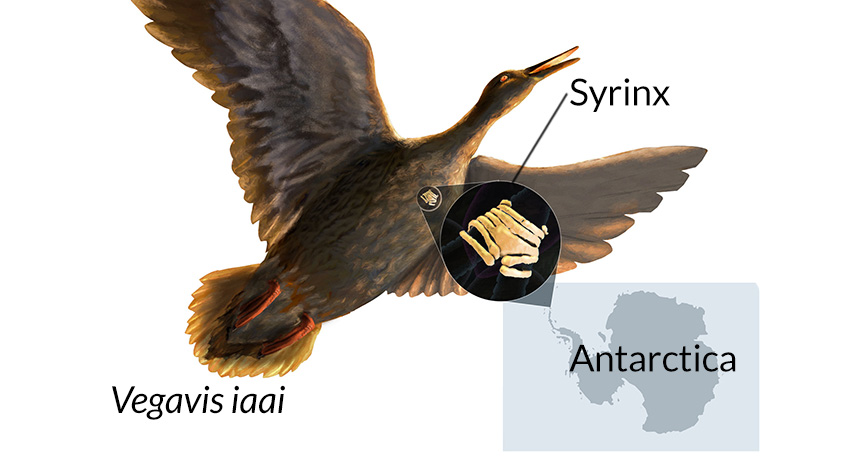Birds’ honks filled Late Cretaceous air

Some ancient birds may have sounded like honking ducks.
For the first time, scientists have discovered the fossilized remains of a voice box from the age of the dinosaurs. The sound-making structure, called a syrinx, belonged to Vegavis iaai, a bird that lived 68 million to 66 million years ago, researchers report October 12 in Nature.
“It may be a once-in-a-lifetime discovery,” says evolutionary biologist Patrick O’Connor of Ohio University in Athens, who wrote a commentary in Nature about the fossil. Now, he says, the hunt will be on to find voice boxes in other fossils.
The new work helps fill in the soundscape of the Late Cretaceous Epoch. It could also offer hints about sounds made by all sorts of dinosaurs, says study coauthor Julia Clarke of the University of Texas at Austin.
Unlike in humans, where the larynx lies below the throat, birds’ voice boxes rest inside the chest at the base of the windpipe. Stacked rings of cartilage anchor vibrating membranes that make sound when air whooshes through.
This delicate structure doesn’t typically fossilize. In fact, scientists have previously spotted just a few syrinxes in the fossil record. The oldest known, from a wading bird, was about 50 million years old. Clarke’s team examined that syrinx, which hadn’t been studied before, and the one from V. iaai.
The V. iaaifossil, a partial skeleton discovered on an island off the coast of Antarctica, was removed from a rock about the size of a cantaloupe, Clarke says. Just one small area remained encased in rocky material. Everyone thought that bit was trivial, she says. But “it was within that tiny little section that I saw the syrinx.” Three-dimensional CT scans let her peer within the rock and see the telltale rings of a voice box, a structure roughly half the size of a multivitamin pill. “It was one of the biggest, happiest days of my career,” Clarke says.
Biologist Philip Senter of Fayetteville State University in North Carolina, who was not involved in the study, echoes Clarke’s enthusiasm. “It’s quite exciting to find such a rarely preserved structure,” he says. Seeing it in 3-D will make paleontologists “chortle joyously.”
Comparing the fossil with living birds helped Clarke and her team figure out what sounds the ancient bird might have made. Both the bird’s skeleton and its syrinx suggest it squawked like today’s ducks and geese.
The find also proves that voice boxes from dinosaurs’ time can indeed fossilize. No one has found the structures in nonavian dinosaurs, Clarke says. “That suggests that most dinosaurs may not have had a syrinx.”
Instead, she proposes, dinosaurs like Tyrannosaurus rex and Stegosaurus might have made noises like crocodiles: deep “booming” sounds generated in the back of the mouth.